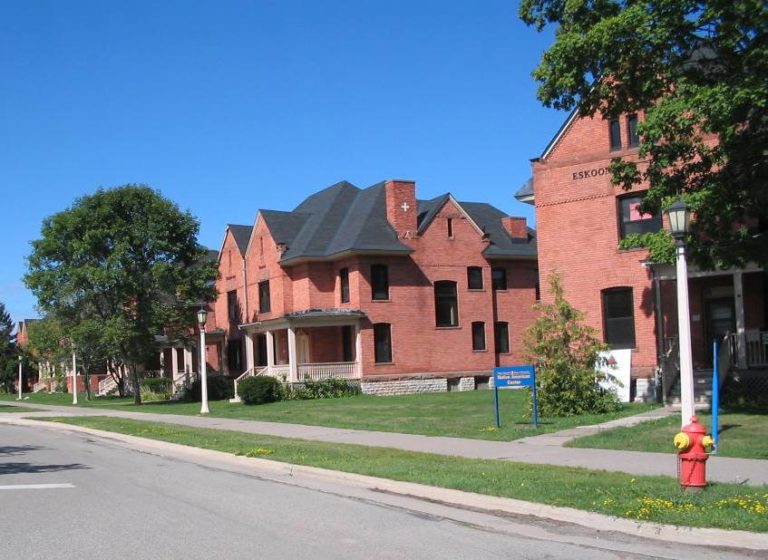The city of Sault Ste. Marie was founded in 1668, but there were groups inhabiting the area for longer than the 350 years we have been a city. If we were to write a story about all of the historical sites of Sault Ste. Marie, Michigan, it would be incredibly long and detailed. Instead of telling you the full history, we will rather be touching on the most prominent historical sites that you can visit year-round in the Soo.
1. Holy Name of Mary Pro-Cathedral

Holy Name of Mary Pro-Cathedral was originally built in 1668 by Jesuit missionaries. The current cathedral was constructed in 1881, making it the fifth church building since the original structure. This historic church is located on Portage Ave. next to the Tower of History. Interesting fact: the church originally built the Tower of History. You can learn more about the history of the Holy Name of Mary Pro-Cathedral here.
2. Fort Brady

Fort Brady was constructed by General Hugh Brady in 1822 on the bank of the St. Marys River. This year-round destination is located in downtown Sault Ste. Marie on Historic Water Street. The original fort is gone, but a replica twelve-foot and historically-accurate picket fence still stands in Brady Park to give visitors a visual of the fort’s walls. Make sure to take a stroll up Water St. and read all of the historical pedestals to learn more about Sault Ste. Marie’s origins.
In 1892, Fort Brady built new developments up on the hill and granted its land on the St. Marys River to the now Soo Locks to make way for larger shipping channels (locks). You may have driven past without ever know that Lake Superior State University was once the “new” Fort Brady. Many of the officer housing still stands and is in use on the campus. We can’t do justice to its full history in just a few lines, so to learn more please visit here.

3. The Original State Lock

The original State Lock (Soo Locks) was completed in 1855 by the State of Michigan. The lock was controlled by the State until the 1870s. When it was apparent that a larger lock needed to be built, the State sought support from the Federal Government. The rest is history, and you can read the full details here of the six subsequent locks that were built. The Soo Locks Park is open year-round and services boats from March 25 to January 15 of each shipping season.
4. Maple Ridge Cemetery

Considered at the time the “outskirts of town,” Maple Ridge Cemetery is located across from Neville’s Superette at 1512 Ashmun St, just outside of downtown Sault Ste. Marie. This cemetery was established in 1874 and closed in 1901 when people began to move closer to this area. After Maple Ridge closed, Riverside Cemetery, which is still in use, opened on Riverside Drive east of the downtown. Riverside Cemetery has a solemn and special Potters Field of the unknown dead. Local Historian Caroline Grabowski discovered the names of many of the dead in the mass grave, and the community came together to place a plaque so they won’t be forgotten again.
5. Chippewa County Courthouse

Our County Court House was built in 1877 and it’s a fine historic building, but far more accessible than these hallowed halls of law are the wonderful statues on the front lawn. Located just four blocks from the Soo Locks, the pair of statues were given to the City by Stella B. Osborn, the wife of the only Upper Peninsula Governor of the State of Michigan (he also happened to live in the Soo for a time). “The Crane of the Sault” and “The Wolf of Rome” are both located on the north lawn on Maple St. For more information about the statues and their story, read more here.
6. Federal Building

Just east of downtown Sault Ste. Marie, you can revel in the amazing architecture of the Federal Building, now known as City Hall. Built in 1910, this historic building served as the Post Office and Federal Government operations were headquartered in Sault Ste. Marie. The building was restored in 2011 to accommodate the growing City Government. During the restoration, efforts were made to keep the building looking as it had when it was built one-hundred years prior. Stop by and visit us at 225 E Portage Ave. to explore the public areas of our beautiful building.
7. The Ramada Plaza Ojibway Hotel

New Year’s Eve of 1927, the doors opened to Sault Ste. Marie’s now historic hotel, the Ramada Plaza Ojibway Hotel. As we mentioned earlier, Chase Salmon Osborn, the only Michigan Governor from the Upper Peninsula, resided in Sault Ste. Marie for a number of years. Osborn donated the land where the hotel was built and also provided $50,000 towards the construction. It was his dream to build a fine, elegant hotel.
The next time you’re visiting Sault Ste. Marie, take the time to explore these historic locations that you may not have noticed before—it’s a great way to learn about the history of Michigan’s first city. Share the photos of your historic adventures in Sault Ste. Marie on social media with the hashtag #ILovetheSoo!
We know we had to summarize a LOT of great information–what would you have included?






